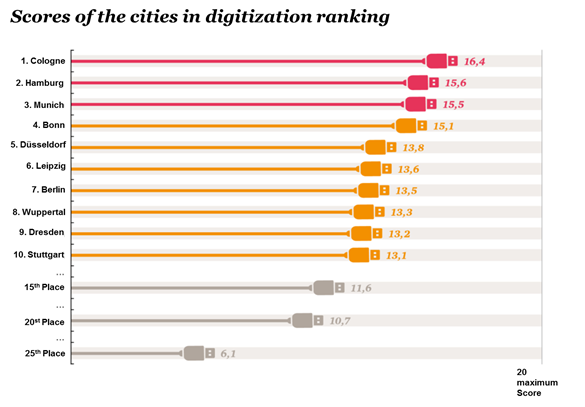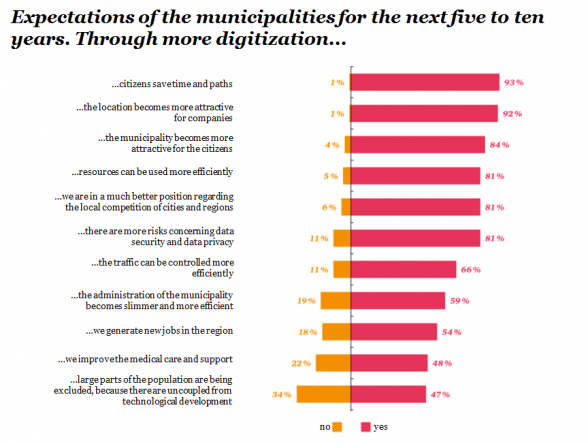The Digitization of German Cities

Who will you meet?
Cities are innovating, companies are pivoting, and start-ups are growing. Like you, every urban practitioner has a remarkable story of insight and challenge from the past year.
Meet these peers and discuss the future of cities in the new Meeting of the Minds Executive Cohort Program. Replace boring virtual summits with facilitated, online, small-group discussions where you can make real connections with extraordinary, like-minded people.
The digital era has arrived! We communicate – always and everywhere around the world, 24/7. There is no area in our lives, society and economy left, that is not yet touched and influenced by digitization. Smart Phones and tablets conquered our households. Online shopping, online banking, online communication, online living…well, let’s say “online-ing everything” affects our lives, our communication and our entertainment. Big data analytics as well as the internet of things provide unforeseen prospects in terms of data usage and information (over)flow. And while some cities in Asia, USA and Europe are smart city pioneers, German cities and municipalities seem to have difficulties keeping up with the speed of digitization. But increasingly the digitization of cities becomes a hot topic for urban development in Germany and German cities start to hit the smart city road.
Bottom up demands and top down challenges
Businesses already changed their entire product portfolios. Since customers long for digital services, digital products and services became standard. They familiarize the digital product and service range. Customers of companies are at the same time citizens of cities. Accustomed to digital service offerings in their daily lifes, they understandably also demand online service offerings from their municipality. They don’t want to visit the citizen center several times to apply for a new ID. They don’t want to wait in line only to apply for a resident parking permit – and these are just two of hundreds of examples for the inevitable need of having to deal with brick-and-mortar citizen centers in person. But this is often daily routine in most German cities.
Parallel to the online service requests, the aspiration of transparency from political decisions and administrative processes is wanted, but yet, barely seen online. Even though the digitization provides new options to participate and incorporation of citizen know-how. Citizens want to participate online, to have a say, to take part in political decisions and express their opinions, not least because they know that participating online is possible and no technical wonder anymore.
Furthermore, cities and municipalities are facing different challenges, for instance the demographic change or the urbanization: While big cities are bursting at al seams, rural districts lose more and more residents. Cities face challenges in issues like mobility, medical transport, traffic jams, security aspects, administration efficiency and the like. Digitization, a challenge in itself, plays also a crucial part in overcoming these challenges. It is the ideal tool to compensate the facing deficits. Mobility issues in cities and rural districts can for instance be unstressed through mapping and coordinating traffic by using sensors, or by individual mobility concepts that ease city traffic and allow public transport even in rural districts. The medical care supply in metropolises and rural areas can be guaranteed through telemedicine and eHealth. And the life of citizens can be alleviated by providing digital services and a strong digital infrastructure.
Beyond overcoming regional challenges, digitization also is an opportunity to reduce costs. Digitization makes administrative processes leaner and more efficient. For example by implementing a document management system, up to 15% of personnel costs can be reduced. Through the application of predictive analytics, cities are able to plan even better ahead and reduce the deployed resources.
Digitization as competitive advantage
Companies today are already far more digitized than cities. This means they also need much more intelligent digital infrastructure than un-digitized businesses. In reverse, that comes to one fact: Businesses only settle where they can count on a good and profound digital infrastructure, starting with broadband availability. In this way, the digital local infrastructure affects economic competitiveness. How do we know?
PricewaterhouseCoopers (PwC) published a study on the digitization of German cities in 2015. We assessed the level of digitization of Germanys 25 biggest cities) using 20 indicators and compared the level of digitization of each city with their individual economic performance in different areas like the number of businesses registered, the amount of highly qualified people living in the city, the development of industrial taxes as well as the employment level and the growth of the city population. This comparison reveals: The top 10 most digitized cities show, on average, significantly better statistics than the cities ranked 11 to 25.
Cologne is the digitized city in Germany
A look at the digitization rankings show: Cologne ranks first place and scored 16.4 out of 20. Hamburg and Munich are in second and third place, respectively. The first four places offer their citizens a variety of online services and superior fast broadband with city-wide coverage. Looking at places five to ten, one can see that these cities offer different online services, but the complexity and the scope is limited.

The indicators we have researched and investigated were evaluated concerning their significance by digitization experts. We tried to cover all relevant areas in city life e.g participation, social media, online services, broadband, digital divide, mobility etc. As a result there are 20 indicators, which have been analyzed concerning their availability in the conducted cities.
Digitization – opportunity and challenge
In addition to the ranking, we interviewed over 200 German cities with a population of more than 50,000 citizens. The interviews were conducted via telephone through an independent market research organization. In combination with 25 in-depth interviews we portrayed a unique picture of the current status of digitization in German cities.
85% of the interviewees see opportunities for the city or region in terms of digitization. Simultaneously, the municipal finances and households represent a major challenge for their cities. The difficult budgetary situation exacerbates the realization of digitization projects and slows down the digital development of cities, which is why digitization is seen as an additional challenge for municipalities. In a self-assessment, 57% of the cities interviewed evaluate their state of digitization as “ rather high” or “very high”, while 42% assess their status as “rather low” or “very low”. In comparison to the actual performed digitization projects, cities tend to overestimate their digitization efforts. In spite of this, the self-estimation of German municipalities shows a digital division in terms of a north-south gap. Municipalities in the southern or western parts of Germany evaluate the state of digitization much better than municipalities in the northern or eastern part.
Looking at the driver of digitization it becomes apparent that the municipality administration (50.7%) as well as private firms (38.3%) are the main driver of digitization in cities and regions. It also shows that citizens are proponents of the digitization process, but do not push them actively. Only 12.4% of the interviewees see citizens as driver of digitization.
In terms of financing digitization projects the municipal household is the main source of digitization budget. 90% of the interviewed cities finance their digitization projects out of the municipal budget.
Brave new digital future
We also asked the interviewees to assess the effects of digitization to the years 2020-2025. It appears that German cities and regions expect the city/region to be more attractive, if the digitization is widespread.
Successful to the digital future – recommendations for action
Cities and regions in Germany already recognized: digital technologies help becoming more efficient, modern and more attractive. A lot of the efforts so far are isolated solutions. The collaboration across the boundaries of federal departments, cities and regions must be strengthened in order to learn from each other and generate economies of scale. All too often a strategic control is missing. With 10 action recommendations we want to help cities and regions to successfully develop into a digital future:
- Develop a digital strategy
- Make digitization a Top-Management priority
- Hire a Chief Digital Officer
- Create a digital culture
- Learn from each other
- Use economies of scale, share where possible
- Take the users view
- Show and address financing gaps
- Fibre optic networks are the key
- Communicate successful digitization projects
More Information about the study: www.pwc.de/digitale_stadt or contact me: sarah.guesken@de.pwc.com
Discussion
Leave your comment below, or reply to others.
Please note that this comment section is for thoughtful, on-topic discussions. Admin approval is required for all comments. Your comment may be edited if it contains grammatical errors. Low effort, self-promotional, or impolite comments will be deleted.
Read more from MeetingoftheMinds.org
Spotlighting innovations in urban sustainability and connected technology
Middle-Mile Networks: The Middleman of Internet Connectivity
The development of public, open-access middle mile infrastructure can expand internet networks closer to unserved and underserved communities while offering equal opportunity for ISPs to link cost effectively to last mile infrastructure. This strategy would connect more Americans to high-speed internet while also driving down prices by increasing competition among local ISPs.
In addition to potentially helping narrow the digital divide, middle mile infrastructure would also provide backup options for networks if one connection pathway fails, and it would help support regional economic development by connecting businesses.
Wildfire Risk Reduction: Connecting the Dots
One of the most visceral manifestations of the combined problems of urbanization and climate change are the enormous wildfires that engulf areas of the American West. Fire behavior itself is now changing. Over 120 years of well-intentioned fire suppression have created huge reserves of fuel which, when combined with warmer temperatures and drought-dried landscapes, create unstoppable fires that spread with extreme speed, jump fire-breaks, level entire towns, take lives and destroy hundreds of thousands of acres, even in landscapes that are conditioned to employ fire as part of their reproductive cycle.
ARISE-US recently held a very successful symposium, “Wildfire Risk Reduction – Connecting the Dots” for wildfire stakeholders – insurers, US Forest Service, engineers, fire awareness NGOs and others – to discuss the issues and their possible solutions. This article sets out some of the major points to emerge.
Innovating Our Way Out of Crisis
Whether deep freezes in Texas, wildfires in California, hurricanes along the Gulf Coast, or any other calamity, our innovations today will build the reliable, resilient, equitable, and prosperous grid tomorrow. Innovation, in short, combines the dream of what’s possible with the pragmatism of what’s practical. That’s the big-idea, hard-reality approach that helped transform Texas into the world’s energy powerhouse — from oil and gas to zero-emissions wind, sun, and, soon, geothermal.
It’s time to make the production and consumption of energy faster, smarter, cleaner, more resilient, and more efficient. Business leaders, political leaders, the energy sector, and savvy citizens have the power to put investment and practices in place that support a robust energy innovation ecosystem. So, saddle up.







0 Comments